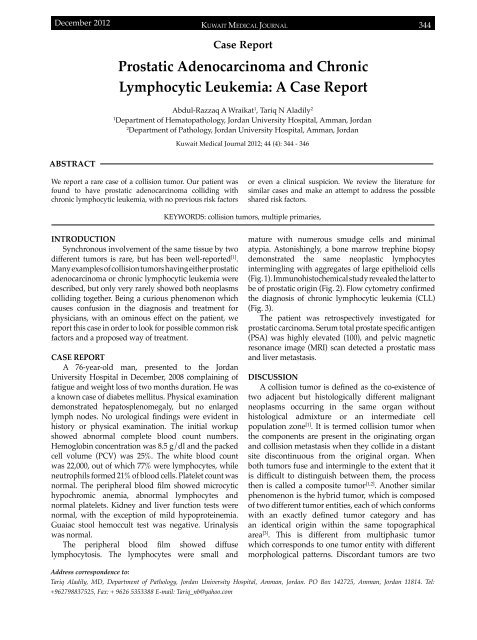Vol 44 # 4 December 2012 - Kma.org.kw
Vol 44 # 4 December 2012 - Kma.org.kw
Vol 44 # 4 December 2012 - Kma.org.kw
You also want an ePaper? Increase the reach of your titles
YUMPU automatically turns print PDFs into web optimized ePapers that Google loves.
<strong>December</strong> <strong>2012</strong><br />
KUWAIT MEDICAL JOURNAL 3<strong>44</strong><br />
Case Report<br />
Prostatic Adenocarcinoma and Chronic<br />
Lymphocytic Leukemia: A Case Report<br />
Abdul-Razzaq A Wraikat 1 , Tariq N Aladily 2<br />
1<br />
Department of Hematopathology, Jordan University Hospital, Amman, Jordan<br />
2<br />
Department of Pathology, Jordan University Hospital, Amman, Jordan<br />
Kuwait Medical Journal <strong>2012</strong>; <strong>44</strong> (4): 3<strong>44</strong> - 346<br />
ABSTRACT<br />
We report a rare case of a collision tumor. Our patient was<br />
found to have prostatic adenocarcinoma colliding with<br />
chronic lymphocytic leukemia, with no previous risk factors<br />
or even a clinical suspicion. We review the literature for<br />
similar cases and make an attempt to address the possible<br />
shared risk factors.<br />
KEYWORDS: collision tumors, multiple primaries,<br />
INTRODUCTION<br />
Synchronous involvement of the same tissue by two<br />
different tumors is rare, but has been well-reported [1] .<br />
Many examples of collision tumors having either prostatic<br />
adenocarcinoma or chronic lymphocytic leukemia were<br />
described, but only very rarely showed both neoplasms<br />
colliding together. Being a curious phenomenon which<br />
causes confusion in the diagnosis and treatment for<br />
physicians, with an ominous effect on the patient, we<br />
report this case in order to look for possible common risk<br />
factors and a proposed way of treatment.<br />
CASE REPORT<br />
A 76-year-old man, presented to the Jordan<br />
University Hospital in <strong>December</strong>, 2008 complaining of<br />
fatigue and weight loss of two months duration. He was<br />
a known case of diabetes mellitus. Physical examination<br />
demonstrated hepatosplenomegaly, but no enlarged<br />
lymph nodes. No urological findings were evident in<br />
history or physical examination. The initial workup<br />
showed abnormal complete blood count numbers.<br />
Hemoglobin concentration was 8.5 g/dl and the packed<br />
cell volume (PCV) was 25%. The white blood count<br />
was 22,000, out of which 77% were lymphocytes, while<br />
neutrophils formed 21% of blood cells. Platelet count was<br />
normal. The peripheral blood film showed microcytic<br />
hypochromic anemia, abnormal lymphocytes and<br />
normal platelets. Kidney and liver function tests were<br />
normal, with the exception of mild hypoproteinemia.<br />
Guaiac stool hemoccult test was negative. Urinalysis<br />
was normal.<br />
The peripheral blood film showed diffuse<br />
lymphocytosis. The lymphocytes were small and<br />
mature with numerous smudge cells and minimal<br />
atypia. Astonishingly, a bone marrow trephine biopsy<br />
demonstrated the same neoplastic lymphocytes<br />
intermingling with aggregates of large epithelioid cells<br />
(Fig. 1). Immunohistochemical study revealed the latter to<br />
be of prostatic origin (Fig. 2). Flow cytometry confirmed<br />
the diagnosis of chronic lymphocytic leukemia (CLL)<br />
(Fig. 3).<br />
The patient was retrospectively investigated for<br />
prostatic carcinoma. Serum total prostate specific antigen<br />
(PSA) was highly elevated (100), and pelvic magnetic<br />
resonance image (MRI) scan detected a prostatic mass<br />
and liver metastasis.<br />
DISCUSSION<br />
A collision tumor is defined as the co-existence of<br />
two adjacent but histologically different malignant<br />
neoplasms occurring in the same <strong>org</strong>an without<br />
histological admixture or an intermediate cell<br />
population zone [1] . It is termed collision tumor when<br />
the components are present in the originating <strong>org</strong>an<br />
and collision metastasis when they collide in a distant<br />
site discontinuous from the original <strong>org</strong>an. When<br />
both tumors fuse and intermingle to the extent that it<br />
is difficult to distinguish between them, the process<br />
then is called a composite tumor [1,2] . Another similar<br />
phenomenon is the hybrid tumor, which is composed<br />
of two different tumor entities, each of which conforms<br />
with an exactly defined tumor category and has<br />
an identical origin within the same topographical<br />
area [3] . This is different from multiphasic tumor<br />
which corresponds to one tumor entity with different<br />
morphological patterns. Discordant tumors are two<br />
Address correspondence to:<br />
Tariq Aladily, MD, Department of Pathology, Jordan University Hospital, Amman, Jordan. PO Box 142725, Amman, Jordan 11814. Tel:<br />
+962798837525, Fax: + 9626 5353388 E-mail: Tariq_nb@yahoo.com
















